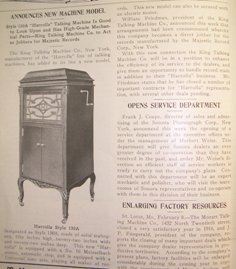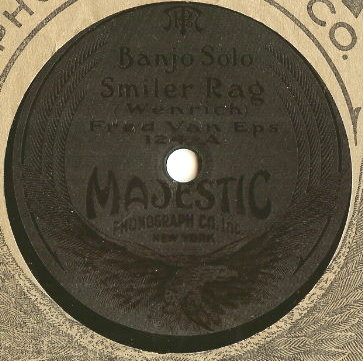

There was also information that on December 1, 1916 only seven of the twenty 9 inch records were ready for shipment. This may be a clue why an example has been seen as having 2002-A on one side and 2005-A on the other as the B sides were probably not ready. Allegedly by mid-December all twenty were ready.
In spite of what the agreement stated about only using the name “Majestic Record” most of the records said “Majestic Phonograph Co., Inc.” on them. This was because most of the matrices had already been made prior to the contract as they had been pressing records for months. One of the four variations of labels does use Majestic Record instead. The agreement had also stipulated that the sleeves would not bear the Majestic Phonograph Co., Inc. name. However, according to testimony, they already had 250,000 printed up prior to the contract. To date, I have seen no indication any other type of sleeve was printed.
Just prior to December 25, 1916 a Mr. Tauber was hired by Majestic Phono to be their new sales manager. He had labels printed up of the Majestic Phono name to be placed over the Majestic Record name on the catalogs they had in stock that were shipped with every order5. So here’s the first proof, if true, that the two companies were about to part ways.
On January 3, 1917 John E. Lange, Secretary and Treasurer for Majestic Phono sent a letter to Majestic Record (Figure 15) stating that the prices of records were going up to 14 ˝ cents each for 7 inch records and 27 ˝ cents each for 9 inch records. This, effectively, was telling Majestic Record they are just like any other jobber. Although Majestic Phono didn’t admit to it in testimony they were planning to sell directly as they wanted out of the contract. This was admitted to in a letter by Robert Shaal, who had left Majestic Phono on December 2, 1916. Discussions took place between the two companies on January 8, 1917 trying to rectify the situation but Majestic Phono did not change their position saying they were losing money at 12 ˝ cents and would not carry out the contract. The problem for Majestic Record was that they sold the records to the trade at 14 ˝ cents so they effectively had no business. Subsequent to this meeting Majestic Record offered a compromise of 13 ˝ cents but that was also denied. At this point Majestic Phono no longer filled Majestic Record orders and the relationship had come to an end.
On January 25, 1917 Majestic Phono was served with the complaint from Majestic Record which they needed to respond to. It was an injunction to prevent Majestic Phono from selling, delivering and soliciting sales of records and honor the original agreement with Majestic Record. There were numerous claims, many of which have already been discussed. One claim was that Majestic Record felt they did not have adequate remedy at law due to the fact that Majestic Phono was insolvent. They aimed to prove that Majestic Phono defaulted on the contract, succeed with the injunction and it would force them to continue selling records to Majestic Record. However, Majestic Phono denied the insolvency so the motion of injunction was denied. This was the last that was heard of Majestic Record as it appears they gave up at this point.
In the January issue of TMW the only thing I found related to Majestic were the record bulletins on pages 109-110 showing what appears to be the final 22 new record releases, 10 nine inch records and 12 seven inch records.
In the February issue of TMW there were no ads or record releases listed for Majestic. Nor were there any up through June 1917, which is the last issue I had time to research. However, there is mention in the February issue related to the distribution of Majestic records by the King Talking Machine Company. King are the makers of the Harrolla line of phonographs. On page 106b (Figure 16.) there's an article about a new machine, the 150A. In the article is also information announcing an agreement with Majestic - "William Freidman, president of King Talking Machine
King also took out a full page ad, page 56 (Figure 17.) in the same issue showing off some of their phonographs as well as announcing the agreement with Majestic.
Also in the February issue, TMW did a little marketing of their own by taking out a full page ad reprinting a letter by William Friedman of King (Figure 18.). In it Mr. Friedman expresses his thanks to TMW for his success in gaining two new contracts by having advertised in the January issue of TMW. While there's no mention of Majestic it was an interesting piece in that perhaps there was some link between their advertisement and the deal struck with Majestic. I did not see the January advertisement when I had access to these issues and need to revisit this issue and get a copy of it to see if it holds any clues to their dealings with Majestic.
On page 54 of the February issue was an announcement about the incorporation of King - "The King Talking Machine Co, Inc. was incorporated last week for the purpose of dealing in talking machines and records, the capitalization of the firm being $5,000, and the incorporators being M.W. and P.J. Friedman, of New York City."'
In the trade directory of the February issue King is listed under both "Records" and "Machines." However, Majestic is only listed under "Attachments."
In the March issue of TMW King has a half page ad on page 101. In the ad it states "We are direct jobbers for Majestic records. Let us fill your record orders" (Figure 19.) So it would appear even after the court case Majestic Phono was still delivering records to whatever customers it had.
In searching through April, May and June issues of TMW I found nothing on King or Majestic. In the June trade directory neither company is listed.
Searching the New York Times for Majestic Record or Phono there is no sign that they advertised here. One thing found was in the January 30, 1917 NY Times under "Calendars and Decisions," page 16 (Figure 20.) which is the court case providing most of the details for this article.
Lastly, in the New York Times for July 13, 1917, page 14, there’s notice of a $379.91 judgement against Majestic Phonograph Co., Inc. by Einson, Inc. (Figure 21.) Einson, Inc. was apparently a
And, finally, the one piece of information I've found that definitively tells of the end of Majestic is an announcement in the August 1917 issue of Talking Machine World regarding the bankrupcy of Majestic Phono (Figure 22.). In it, there is mention of "Emson, Inc." which is likely a typo. The NY Times listed the judgement with Einson, Inc.
Around January 18 or 19, 1917 Jacques Kohner visited Henry Hotaling at his home. Kohner stated that he and Robert Shaal were contemplating going into the business of manufacturing records and offered him a position as electro-plater, which is what he did for Majestic Phono. Hotaling only said that he’d think about it1. It’s not known what happened with Hotaling but Kohner did move on in the record industry.
Kohner's first known stop was at the Paroquette Record Manufacturing Company, Inc., makers of the Par-O-Ket record. Paroquette had been started by recording artists Henry Burr and Fred Van Eps in 1916. They manufactured 7" vertical cut, etched label records. He was hired as sales manager and it was announced in the August 1917 issue of Talking Machine World (Figure 23.). He didn't stay long.
Kohner then moved on to the Lyraphone Company of
Kohner would leave Lyraphone in May, 1921 to form the Clarion Record Company. Labels produced by Clarion were Cardinal, Clarion, Cleartone, Melva and Royal. Announcements for the first Clarion records were in the September 1921 Talking Machine World. Clarion would only last into 19226.
Sources:
1 Majestic Record Corp. vs. Majestic Phonograph Co.,Inc., 5526, New York County Supreme Court, Deposition of Henry Hotaling who began work in May 1916 for Majestic Phonograph Co., Inc. as electro-plater, part of the process of making records.
2 Certificate of Incorporation for Majestic Record Corporation
3 Majestic Record Corp. vs. Majestic Phonograph Co.,Inc., 5526, New York County Supreme Court, Deposition of Walter Friedrichs, Bookkeeper for Majestic Phonograph Co., Inc.
4 Majestic Record Corp. vs. Majestic Phonograph Co.,Inc., 5526, New York County Supreme Court, Deposition of Albert J. Appell, Treasurer and attorney for Majestic Phonograph Co., Inc.
5 Majestic Record Corp. vs. Majestic Phonograph Co.,Inc., 5526, New York County Supreme Court, Deposition of Morris I. Weissman, Shipping Clerk for Majestic Phonograph Co., Inc.
6 Sutton, Alan & Kurt Nauck. American Record Labels and Companies, An Encyclopedia (1891-1943).